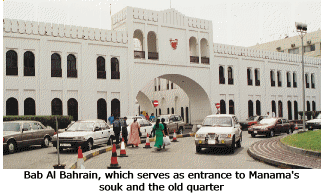|
Everyone was an architect
Houses weren't planned much beforehand; instead they were expanded when necessary (again, a striking difference with modern houses, which lack the more organic nature of their randomly built predecessors).
Because of the use of local materials everyone knew what to do and how to do it; nowadays you need the skills of highly educated professionals who use hi-tech building materials.
 Importance of the family Importance of the family
The family is very important to the Arab people. Usually the whole family - parents, children, their spouses, their children, etc - lived in the same house sharing all the rooms, with the bedrooms as their only private, personal spaces. And if not in the same house, the children would still live in the house next door.
A typical Arabic household was really a small, self-sufficient community, well suited to manage in the harsh environment.
The streets
A typical feature of the old towns was the narrow winding alleys, in comparison to the modern, six-lane highways running through the cities in the Gulf.
Those towns were made for pedestrians with no parking problems and traffic jams - just drive through the old souk in Muharraq and try to find a parking place and you'll get the idea.
However, the main reason for the buildings to be built so close to each other was that then they provided much more shadow to the streets in between, thus easing the oppressive heat.
So you can see, the cities of yesterday were built in total harmony with the surrounding environment and the requirements of Islamic culture.
Survival of the fittest
Thanks to the demands of modern times there are regrettably few of those old, beautiful houses left, and even the ones surviving are often neglected and thus falling apart.
There is always a fear that a new high-rise building or shopping mall will take the place of the old-timers. Money talks, just as it does anywhere else in the world.
Fortunately, however, there is an increasing interest in preserving the past, the cultural heritage in which the old buildings have a major role.
High-rising Manama
In Bahrain, there is not much left of the old Manama. If you take a boat trip, you'll notice the very Manhattan-like silhouette of the Diplomatic Area in Manama, giving a very modern western image for the town.
 Much of this new area is, however, built on reclaimed land. When the Bab Al Bahrain ("gate of Bahrain") was built in 1945, it was almost on the waterfront in the harbour; now you can hardly see the water from it! Much of this new area is, however, built on reclaimed land. When the Bab Al Bahrain ("gate of Bahrain") was built in 1945, it was almost on the waterfront in the harbour; now you can hardly see the water from it!
If you walk along the narrow streets of the souk, you might occasionally run into a old building in ruins, depicting the sad story of total negligence by the owners.
Probably the best way to learn about how things were in the past is the Heritage Centre near Bab Al Bahrain. There you can see how the people used to live, what their homes looked like etc, in a more or less museum-like environment.
If you are more interested in Bahraini culture, pearl diving, the burial mounds and the like, you should visit the National Museum - the building of which is a fine example of mixing modern architecture with traditional Arabic and Islamic architectural elements.
Speaking of Islam, visitors should not miss the fabulous Beit Al Quran (literally "the home of the Holy Quran"). Here you can see a wide selection of the Holy Qurans, old historical copies in different languages and sizes, some as small as a matchbox!
At the same time the visitor can only admire how well the architect has been able to capture the spirit of the holy book into this building.
Old houses of Muharraq
If you want to see more surviving old buildings, you must go to Muharraq, which is the old capital of Bahrain. Wandering through the narrow alleys gives you a good idea of how it must have been to live in the cities here before.
A good place to start your exploration is the fabulous Shaikh Isa bin Ali's House (tel ), the home of the great grandfather of the present Amir, HH Shaikh Isa bin Sulman Al Khalifa. It is one of the best surviving examples of traditional Bahraini architecture.
After recent restoration work, it offers a truly unique opportunity to study the past. Here you can also witness yourself how effective a wind tower really is in cooling the intolerably hot air, especially during the summer!
Near Shaikh Isa's house is the Beit Al Siyadi, or Siyadi House (tel ) which used to belong to a famous pearl merchant in the 19th century. With all the detailed ornamentation on the facade and in the finely carved doors, it is an excellent example of the best architecture from that period.
« Previous Page
1 | 2 | 3
RELATED LINKS:
In search of the Garden of Eden
The birth of Islam in Bahrain
Life before oil
Bahrain's First Family |

